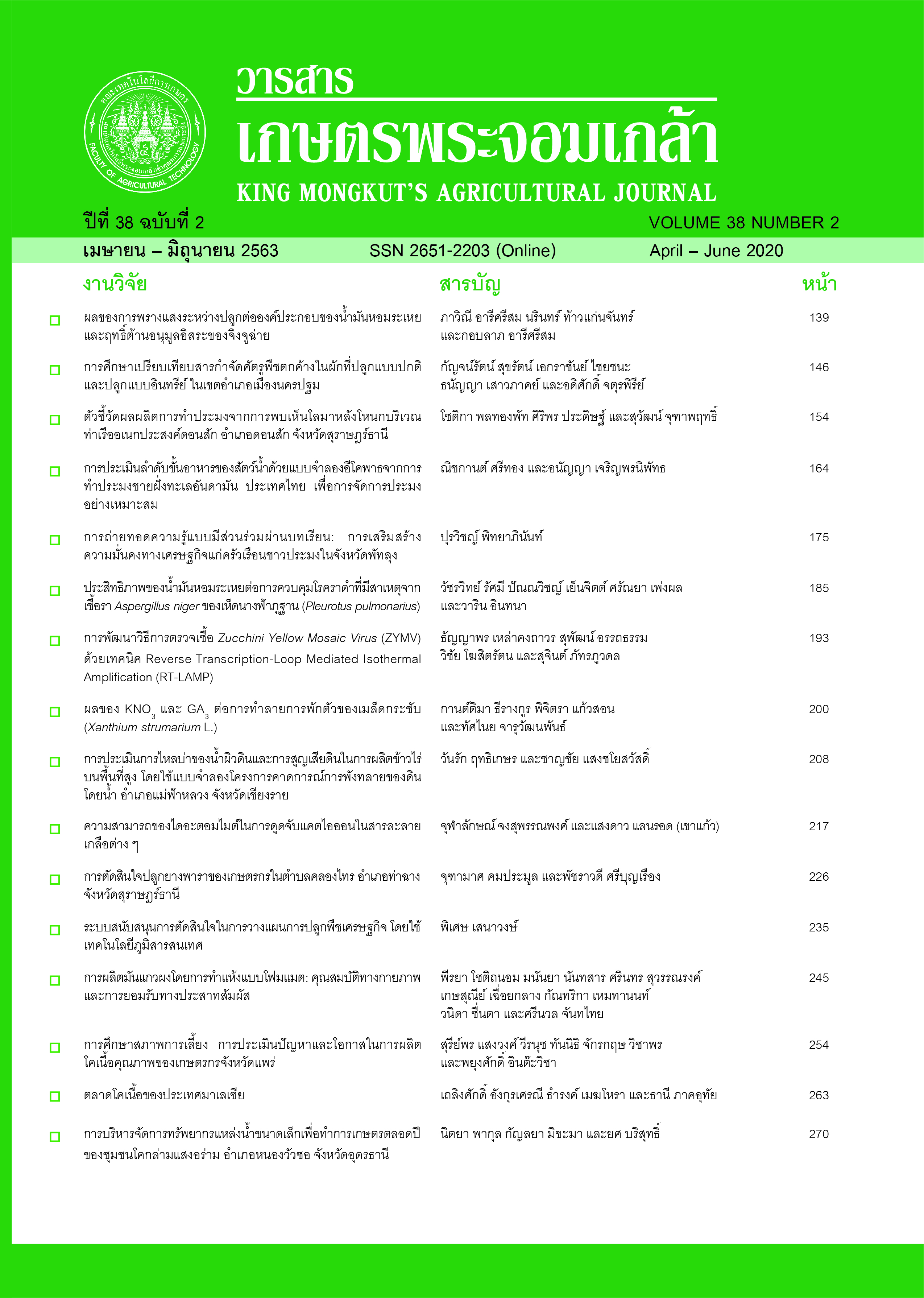Capacity of Diatomite to Sorb Cations in Various Salt Solutions
Main Article Content
Abstract
This investigation aimed to study the ability of diatomite to reduce the levels of various cations that might be found in salt-affected soils. To do so, the sorption capacity of diatomite to sorb the cations (Ca, Na, Fe, and K)
in solutions of their salts, such as NaCl, Na2SO4, CaCl2, CaSO4, KCl, K2SO4, FeCl3, and FeSO4, was studied using
a batch technique. Two diatomite samples and two diatomite-to-salt-solution ratios (i.e. 1:50 and 1:100) were studied. The results showed that diatomite has different capacities to sorb cations depending on the type of salts. Sodium was the element sorbed the most by diatomite, followed by calcium, and iron. In both NaCl and Na2SO4 solutions, diatomite could reduce the weight percentage of sodium in solution by more than 60%. It reduced calcium in CaSO4 solution by more than 80% but only 2-21% of calcium in CaCl2 solution. Diatomite was able to reduce
13-15% of iron in FeCl3 or FeSO4 solution. However, it was not able to remove potassium in KCl or K2SO4 solutions. This demonstrated that diatomite could efficiently sorb some cations in salt solutions and was especially efficient at sorbing sodium.
Article Details
King Mongkut's Agricultural Journal
References
กรมพัฒนาที่ดิน. ม.ป.ป. คุณภาพน้ำเพื่อการเกษตร. http://www.ldd.go.th/Lddwebsite/web_ord/Technical/pdf/P_
Technical03001_2.pdf (1 มกราคม 2562).
จงรักษ์ จันทร์เจริญสุข. 2550. การวิเคราะห์ดินและพืชทางเคมี. กรุงเทพฯ: ภาควิชาปฐพีวิทยา คณะเกษตร มหาวิทยาลัยเกษตรศาสตร์.
สมศรี อรุณินท์. 2539. เอกสารเผยแพร่ทางวิชาการกรมพัฒนาที่ดินเรื่องดินเค็มในประเทศไทย.
http://www.ldd.go.th/Lddwebsite/web_ord/Technical/pdf/P_Technical03035_1.pdf (1 มกราคม 2562).
Al-Degs, Y., Khraisheh, M. A. M., and Tutunji, M. F. 2001. Sorption of lead ions on diatomite and manganese oxides modified diatomite. Water Research 35: 3724-3728.
Anon. 1991. Silicon dioxide and silica gel: Reregistration Eligibility Decision (RED) fact. Environmental Protection Agency (EPA). https://archive.epa.gov/pesticides/reregistration/web/pdf/4081fact.pdf (20 December 2018).
Bakr, H. E. G. M. M. 2010. Diatomite: it characterization, modifications, and applications. Asian Journal of Materials Science 2:
-136.
Chen, M., and Ma, L. Q. 2001. Comparison of three aqua regia digestion methods for twenty Florida soils.
Soil Science Social American Journal 65: 491-499.
Fipps, G. 2017. Irrigation water quality standards and salinity management strategies. Texas A&M AgriLife Extension Service,
Texas A&M University. https://aglifesciences.tamu.edu/baen/wp-content/uploads/sites/24/2017/01/B-1667 (1 April 2019).
Gao, B., Jiang, P., An, F., Zhao, S., and Ge, Z. 2005. Studies on the surface modification of diatomite with polyethyleneimine and trapping effect of the modified diatomite for phenol. Applied Surface Science 250: 273-279.
Guru, M., Venedik, D., and Murathan, A. 2008. Removal of trivalent chromium from water using low-cost natural diatomite.
Journal of Hazardous Materials 160: 318-323.
Khaokaew, S., Takrattanasaran, N., Lachitavong, K., and Landrot, G. 2017. Decrease in rice production during the dry season
in a Central Region of Thailand: linking water, paddy soil, and rice properties. In Goldschmidt 2017 Conference.
Paris, France.
Khraisheh, M. A. M., Al-degs, Y. S., and Mcminn, W. A. M. 2004. Remediation of wastewater containing heavy metals using raw
and modified diatomite. Chemical Engineering Journal 99: 177-184.
Korunic, Z. 1998. Diatomaceous earths, a group of natural insecticides. Journal of Stored Products Research 34(2/3): 87-97.
Korunic, Z. 2013. Diatomaceous earths - natural insecticides. Pesticides & Phytomedicine 28(2): 77-95.
Lemonas, J. F. 1997. Diatomite. American Ceramic Society Bulletin 76: 92-95.
Murer, A. S., Mobil, E., Mc-Clennen, K. L., Ellison, T. K., and Mobil, E. 2000. Steam injection project in heavy-oil diatomite.
SPE Reservoir Evaluation & Engineering 3: 2-12.
National Soil Survey Center. 1996. Soil survey laboratory methods manual (soil survey investigations report No. 42, version 3.0). Lincoln: Natural Resource Conservation Service, United States Department of Agriculture.
Nenadovic, S., Nenadovic, M., Kovacevic, R., Matovic, L., Matovic, B., Jovanovic, Z., and Novakovic. J. G. 2009. Influence of diatomite microstructure on its adsorption capacity for Pb(II). Science of Sintering 41: 309-317.
Osmanlioglu. 2007. Natural diatomite process for removal of radioactivity from liquid waste. Applied Radiation and Isotopes 65: 17-20.
Rietz, D. N., and Haynes, R. J. 2003. Effects of irrigation-induced salinity and sodicity on soil microbial activity.
Soil Biology and Biochemistry 35: 845-854.
Round, F. E., Crawford, R. M., and Mann, D. G. 1992. The diatoms. biology & morphology of the genera.
New York: Cambridge University Press.
Sheng, G., Yang, S., Sheng, J., Hu, J., Tan, X., and Wang, X. 2011. Macroscopic and microscopic investigation of Ni(II) sequestration on diatomite by Batch, XPS, and EXAFS techniques. Environmental Science and Technology 45: 7718-7726.
Sheng, G. D., Hu, J., and Wang, X. K. 2008. Sorption properties of Th(IV) on the raw diatomite - effects of contact time pH, ionic strength and temperature. Applied Radiation and Isotopes 66: 1313-1320.
Sljivic, M., Smiciklas, I., Pejanovic, S., and Pleca, I. 2009. Comparative study of Cu2+adsorption on a zeolite, a clay and a diatomite from Serbia. Applied Clay Science 43: 33-40.
Sumner, M. E. 1995. Sodic soils: new perspectives. In Australian sodic soils: distribution, properties and management,
Naidu, R., Sumner, M. E., Rengasamy, P. eds. pp. 1-34. Melbourne: CSIRO.
Tsai, W. T., Lai, C. W., and Hsien, K. J. 2006. Characterization and adsorption properties of diatomaceous earth modified by hydrofluoric acid etching. Journal of Colloid and Interface Science 297: 749-754.
Wells, A. F. 1984. Structural inorganic chemistry. 5th Edition. Oxford: Oxford University Press.
Yuan, P., Liu, D., Tan, D. Y., Liu, K. K., Yu, H. G., Zhong, Y. H., Yuan, A. H., Yu, W. B., and He, H. P. 2013. Surface silylation of mesoporous/macroporous diatomite (diatomaceous earth) and its function in Cu(II) adsorption: the effects of heating pretreatment. Microporous and Mesoporous Materials 170: 9-19.


